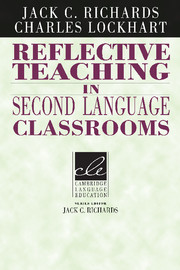Book contents
- Frontmatter
- Contents
- Series editor's preface
- Preface
- Introduction: Teacher development through exploring classroom processes
- 1 Approaches to classroom investigation in teaching
- 2 Exploring teachers' beliefs
- 3 Focus on the learner
- 4 Teacher decision making
- 5 The role of the teacher
- 6 The structure of a language lesson
- 7 Interaction in the second language classroom
- 8 The nature of language learning activities
- 9 Language use in the classroom
- Epilogue
- References
- Index
7 - Interaction in the second language classroom
Published online by Cambridge University Press: 29 January 2010
- Frontmatter
- Contents
- Series editor's preface
- Preface
- Introduction: Teacher development through exploring classroom processes
- 1 Approaches to classroom investigation in teaching
- 2 Exploring teachers' beliefs
- 3 Focus on the learner
- 4 Teacher decision making
- 5 The role of the teacher
- 6 The structure of a language lesson
- 7 Interaction in the second language classroom
- 8 The nature of language learning activities
- 9 Language use in the classroom
- Epilogue
- References
- Index
Summary
A common theme underlying different methods of language teaching is that second language learning is a highly interactive process. A great deal of time in teaching is devoted both to interaction between the teacher and the learners, and to interaction among the learners themselves. The quality of this interaction is thought to have a considerable influence on learning (Ellis 1985). The focus in this chapter is on the nature of classroom interaction and how teachers can influence the kind of interaction that occurs in their own classrooms. These issues will be explored through examining the teacher's action zone within the class, learners' interactional competence, learner's interactional styles, and the effects of grouping arrangements on classroom interaction.
The teacher's action zone
The following notes were written by a teacher after teaching a lesson.
Today I taught a lesson around a discussion on an environmental issue. The lesson went very well First, I introduced the topic by talking about environmental problems in our city and got students to give examples of the major environmental problems we face. This got lots of comments from the class and everybody had an opportunity to say something and express an opinion. After ten minutes I divided the students into small groups and asked them to come up with a solution to one of the problems we talked about. During this time I moved around the class, monitoring the students' language use and giving feedback. After twenty minutes I got the group leaders to report their groups' recommendations and I wrote key points on the board.
- Type
- Chapter
- Information
- Reflective Teaching in Second Language Classrooms , pp. 138 - 160Publisher: Cambridge University PressPrint publication year: 1994

